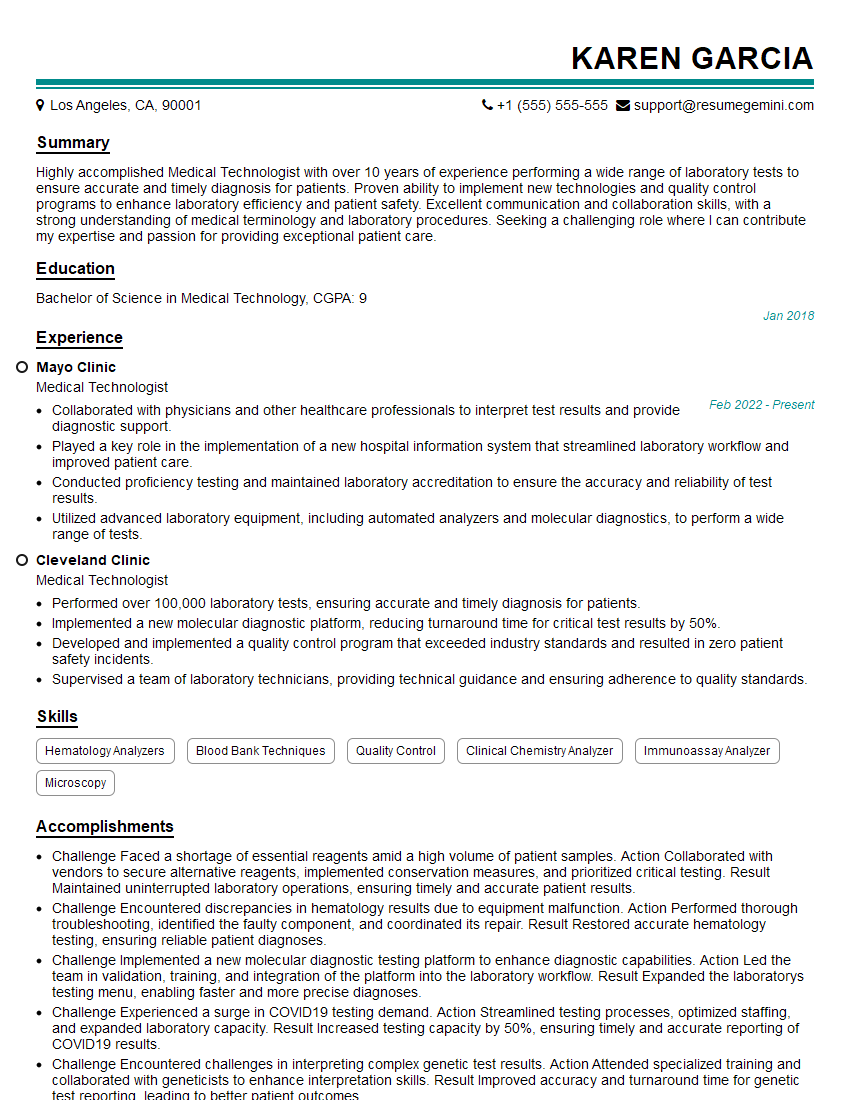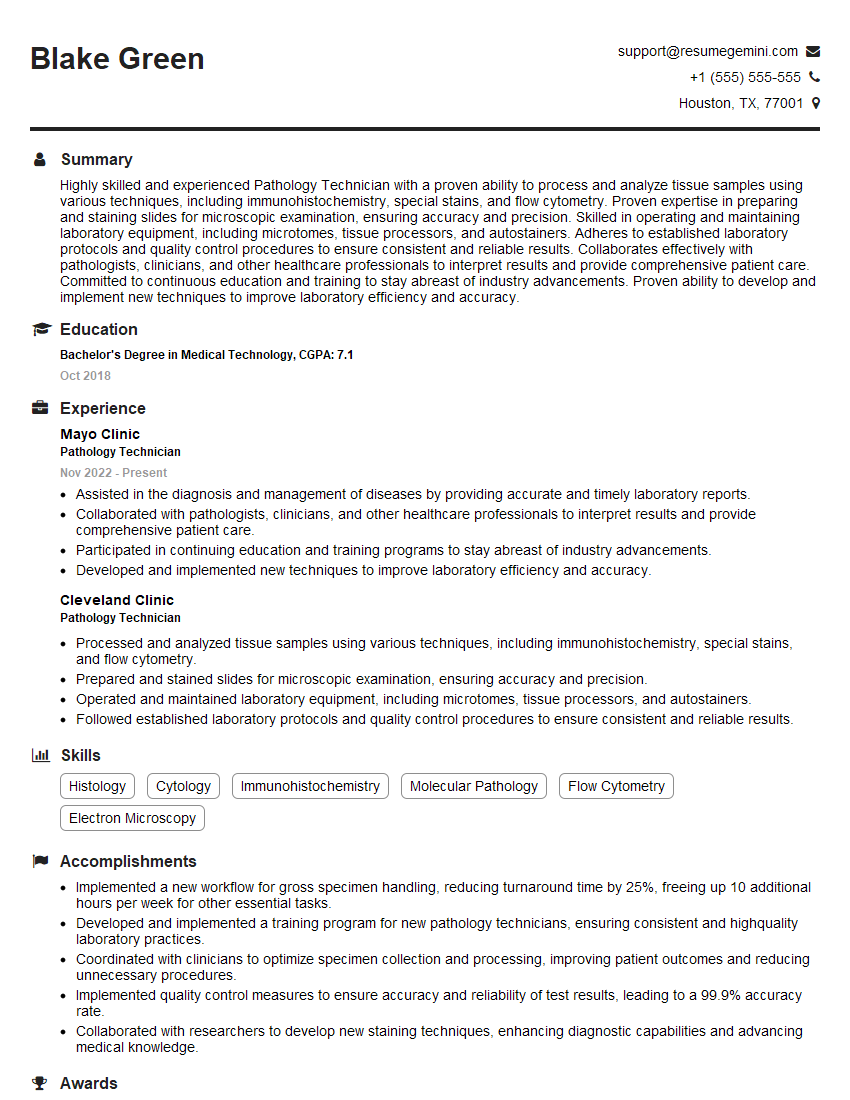The thought of an interview can be nerve-wracking, but the right preparation can make all the difference. Explore this comprehensive guide to Urine Sampling interview questions and gain the confidence you need to showcase your abilities and secure the role.
Questions Asked in Urine Sampling Interview
Q 1. Describe the proper procedure for collecting a urine sample.
Proper urine sample collection is crucial for accurate diagnostic testing. The process begins with clear instructions to the patient, ensuring they understand the procedure and its importance. Hygiene is paramount; patients should thoroughly clean the genital area with a provided antiseptic wipe, wiping from front to back to prevent contamination. Midstream clean-catch collection is the preferred method: the patient begins urinating, then interrupts the stream to collect a mid-portion of urine in a sterile container. This minimizes contamination from the external genitalia and urethra. The container should be filled to the indicated level, usually around 50ml, and the lid should be securely closed immediately.
- Step 1: Patient hygiene – thorough cleaning of the genital area.
- Step 2: Initiate urination, then interrupt the stream.
- Step 3: Collect midstream urine into the sterile container.
- Step 4: Securely close the container.
For patients with difficulty providing a clean-catch sample, such as infants or those with catheters, alternative methods may be used, which should be documented.
Q 2. What are the potential sources of error during urine sample collection?
Several factors can compromise the integrity of a urine sample, leading to inaccurate results. Contamination is a major concern. This can stem from inadequate hygiene before collection, touching the inside of the container, or using a non-sterile container. Improper handling after collection, such as leaving the sample at room temperature for extended periods, can allow bacterial growth and alter the composition of the urine, potentially affecting the results of various tests, including culture and sensitivity, urinalysis, and drug testing. Furthermore, improper labeling or inadequate documentation can lead to sample mix-ups or lost results. Finally, even the patient’s hydration status can significantly influence the outcome of some tests.
Consider this example: If a patient doesn’t properly clean the genital area before collecting a urine sample, skin flora can contaminate the specimen, resulting in a falsely elevated white blood cell count in the urinalysis, potentially masking a true urinary tract infection.
Q 3. How do you ensure the integrity and chain of custody of a urine sample?
Maintaining the integrity and chain of custody of a urine sample is vital for legal and clinical reasons. This involves a meticulous process that begins with proper collection and continues until the sample reaches the laboratory. The sample should be handled with care to avoid spills or contamination. Appropriate temperature control is critical; most samples should be refrigerated immediately after collection unless otherwise specified. A tamper-evident seal should be applied to the container. A chain-of-custody form accompanies the sample at every stage, documenting who handled it, when, and where it was transported. This ensures accountability and prevents unauthorized access or tampering. In forensic toxicology, for example, a meticulously maintained chain of custody is essential for the admissibility of evidence in court.
Think of it like a relay race: each person involved in the process carries the sample (the baton) and records their participation.
Q 4. Explain the importance of proper labeling and documentation for urine specimens.
Accurate labeling and documentation are fundamental to sample identification and traceability. Every urine specimen must be clearly labeled with the patient’s full name, date of birth, date and time of collection, and unique identification number. Additional information such as the ordering physician’s name and the type of test requested may also be included. This information should be consistently recorded in both the laboratory information system (LIS) and manually on the specimen container, ensuring both physical and electronic traceability. Inconsistent or missing information leads to sample rejection, delays in testing, and potentially incorrect results. The patient’s medical record should reflect the details of sample collection.
Imagine a scenario where two patients share similar names: Without proper labeling and identification, their samples could easily be mixed up, resulting in potentially dangerous misdiagnosis.
Q 5. What are the common reasons for rejecting a urine sample?
Several reasons can lead to a urine sample being rejected. The most common include inadequate volume, insufficient labeling, contamination (as discussed earlier), improper collection method, or evidence of tampering. Samples that have been improperly stored or are visibly contaminated (e.g., with feces or menstrual blood) are also typically rejected. Samples that are outdated or arrived past the laboratory’s acceptance time also will be rejected. The reason for rejection is always clearly communicated, allowing for recollection of a new specimen.
For instance, a sample with a significant amount of toilet bowl cleaner present would indicate contamination and will be rejected for analysis.
Q 6. Describe the different types of urine containers and their uses.
Various urine containers are used, depending on the test required. Sterile, leak-proof containers are the most common, typically made of plastic. These are suitable for routine urinalysis, culture, and sensitivity tests. For drug screening or forensic toxicology, specific containers with tamper-evident seals and chain-of-custody documentation are essential. Containers may also vary in size, from smaller containers for pediatric patients to larger containers for 24-hour urine collection. Some specialized tests may require preservative-containing containers or containers designed for specific testing methods.
- Sterile Cups: Standard for routine urinalysis.
- Chain-of-Custody Containers: Used in forensic toxicology and workplace drug testing.
- Preservative Containers: For specific tests where urine composition must remain stable.
Q 7. How do you handle a patient who refuses to provide a urine sample?
When a patient refuses to provide a urine sample, it’s crucial to understand the reason for their refusal. Respectful communication is key. We explore any concerns they might have, emphasizing the importance of the test for their health or treatment. If the refusal is related to privacy concerns, we can try to alleviate their worries by explaining our confidentiality protocols. However, if the refusal is based on something else, like a fear of testing positive, we must emphasize the consequences of not having the testing completed. In some clinical settings, the healthcare provider may need to document the refusal and inform the appropriate personnel, such as the ordering physician. In some cases, the healthcare provider may need to escalate this refusal to the appropriate parties, such as a supervisor or the patient’s legal guardian. It is critical that documentation remains accurate and respectful.
Remember, our primary goal is to maintain a therapeutic relationship with the patient, even when facing challenges.
Q 8. What are the safety precautions involved in handling urine specimens?
Handling urine specimens requires strict adherence to safety protocols to prevent exposure to potentially infectious agents. Think of it like handling any other potentially biohazardous material – caution is key.
- Personal Protective Equipment (PPE): Always wear gloves, and depending on the suspected contents or the risk of splashing, eye protection and a lab coat are recommended. This is crucial to prevent direct contact with the specimen.
- Proper Disposal: Urine specimens should be disposed of according to local regulations. This usually involves discarding in designated biohazard containers.
- Decontamination: Any spills should be immediately cleaned up using appropriate disinfectants, such as 10% bleach solution. Remember, safety starts with prevention.
- Biohazard Labeling: All containers should be clearly labeled as biohazardous material, preventing accidental exposure or mishandling.
- Sharps Safety: If using needles for specimen collection (less common for routine urine samples), exercise extreme caution and dispose of them in designated sharps containers. This is crucial for the safety of yourself and everyone around you.
Remember, a small mistake can have significant consequences. Following these simple steps ensures a safe working environment.
Q 9. What are the different methods used to preserve urine samples?
Preservation methods for urine samples are essential to prevent bacterial growth and maintain the integrity of analytes before testing. The ideal method depends on the tests being performed and the time elapsed until analysis.
- Refrigeration: Storing samples at 4°C (39°F) is the most common method for short-term storage (up to 24 hours). This slows bacterial growth and reduces the breakdown of some analytes.
- Chemical Preservatives: For longer-term storage or specific tests, chemical preservatives like boric acid or thymol may be added. These inhibit bacterial growth and stabilize certain components. However, some preservatives may interfere with specific tests, so this must be carefully considered.
- Freezing: Freezing at -20°C (-4°F) or lower is suitable for long-term storage. However, some analytes may be affected by freeze-thaw cycles, requiring careful handling and often the need to only freeze once.
Imagine refrigeration as putting your sample in a ‘time-out’ to maintain its condition, and chemical preservatives as adding a ‘preservative’ to prevent spoilage.
Q 10. What is the significance of urine color and its variations?
Urine color is a valuable, albeit non-specific, indicator of overall health and hydration. Variations can signal underlying conditions.
- Pale Yellow: Indicates good hydration. This is usually the desired state. Think of it as your body’s efficient waste disposal system working well.
- Dark Yellow/Amber: Suggests dehydration. This means your body isn’t getting enough fluids.
- Red/Pink: Can indicate the presence of blood (hematuria), which could result from kidney stones, infection, or other causes. Further investigation is crucial.
- Orange: May be caused by certain medications, dehydration, or the presence of bilirubin (jaundice).
- Brown: Could be a sign of liver disease, muscle breakdown (rhabdomyolysis), or medications.
- Cloudy/Foamy: Could signify an infection or the presence of protein (proteinuria), potentially indicating kidney disease.
While color alone isn’t diagnostic, it provides an important clue that warrants further investigation if unusual.
Q 11. Explain the process of performing a dipstick urinalysis.
A dipstick urinalysis is a rapid, point-of-care test that provides a preliminary assessment of urine composition. It’s like a quick health check for your urine.
- Collect a fresh, well-mixed urine sample: The first morning sample is often preferred for its higher concentration of analytes.
- Remove the dipstick from its container: Handle the dipstick only by the edges to avoid contamination.
- Dip the reagent pads into the urine sample: Ensure the pads are fully immersed, then remove and hold the dipstick horizontally over the container.
- Remove excess urine by blotting the edge of the dipstick against the side of the container: This ensures clear results and prevents unwanted reactions.
- Compare the color changes of the reagent pads to the color chart provided: Each pad tests for a different analyte. Note the time required, usually 60 seconds or as specified on the product.
- Record the results: Document the color changes and their corresponding readings. This is a crucial step in interpreting the results.
Remember to follow the manufacturer’s instructions carefully, as different dipsticks may have varying read times and color charts.
Q 12. What are the normal values for common urine components?
Normal values for urine components vary slightly depending on factors such as age, diet, hydration status, and the specific laboratory. These are approximations and should be viewed alongside the laboratory’s specific reference ranges.
- pH: 4.5-8.0
- Protein: Negative (trace amounts may be present)
- Glucose: Negative
- Ketones: Negative
- Blood: Negative
- Nitrites: Negative
- Leukocytes (White blood cells): Negative
- Urobilinogen: 0.2-1.0 mg/dL
- Specific gravity: 1.005-1.030
It’s crucial to always consider the patient’s clinical context when interpreting these results.
Q 13. How do you interpret the results of a urine dipstick test?
Interpreting dipstick results requires careful comparison with the color chart and consideration of the patient’s clinical history. Think of it like putting together pieces of a puzzle.
Positive results: Indicate the presence of an analyte above the normal range. For example, a positive glucose result may suggest diabetes. A positive blood result could indicate a urinary tract infection or kidney stones. Positive leukocytes suggest infection.
Negative results: Indicate the absence or presence of an analyte within the normal range.
Important Considerations:
- False positives: Can occur due to contamination, improper technique, or certain medications.
- False negatives: Can occur if the urine is diluted or if the test is not performed correctly.
- Further testing: A positive dipstick result is often just the starting point, usually requiring further investigation such as microscopic urinalysis or urine culture.
Never rely solely on a dipstick result for diagnosis. Always correlate with the patient’s clinical picture and other tests.
Q 14. Describe the microscopic examination of urine sediment.
Microscopic examination of urine sediment involves analyzing the solid components that settle at the bottom of a centrifuged urine sample. It’s like looking at the ‘leftovers’ after the liquid part has been separated. It provides a detailed picture of what’s present in the urine.
The process typically involves:
- Centrifugation: Spinning the urine sample to separate the sediment from the supernatant.
- Sediment preparation: The supernatant is carefully discarded, leaving behind a small volume of sediment.
- Microscopic examination: A drop of sediment is placed onto a microscope slide and examined under a microscope at low and high power. This allows for identification and quantification of various cellular elements and crystals.
Commonly identified components include:
- Red blood cells (RBCs): Presence may indicate glomerulonephritis, kidney stones, or urinary tract infections.
- White blood cells (WBCs): Usually signifies infection.
- Epithelial cells: Usually present in small numbers, large numbers may indicate inflammation or infection.
- Casts: Cylindrical structures formed in the renal tubules, which can reflect renal disease.
- Crystals: Various crystals can be present, some indicative of specific metabolic disorders.
- Bacteria and yeast: Indicative of urinary tract infection.
Microscopic examination of urine sediment provides crucial information for diagnosis and management of various renal and urinary tract conditions.
Q 15. What are the common urinary crystals and their significance?
Urinary crystals are solid particles formed from substances dissolved in urine. Their presence and type can offer clues about underlying metabolic processes or kidney function. Identifying them requires microscopic examination of the urine sediment. Common crystals include:
- Uric acid crystals: These are often yellow-brown, diamond-shaped or rhombic, and can indicate gout, kidney stones, or a high-purine diet. Think of them like tiny, crystallized remnants of purines from things like red meat and organ meats.
- Calcium oxalate crystals: These are generally colorless, octahedral (eight-sided) or envelope-shaped crystals. They’re the most common type of kidney stone and can be associated with dehydration or certain metabolic disorders. Imagine tiny envelopes stuck together!
- Calcium phosphate crystals: These are colorless, prismatic, or star-shaped and are often associated with alkaline urine. They’re less concerning than oxalate crystals, but can still be a sign of underlying issues.
- Amorphous phosphates: These appear as granular debris in alkaline urine and are generally not clinically significant unless present in large quantities.
- Triple phosphate crystals: Also known as struvite crystals, these are coffin-lid shaped and often linked to urinary tract infections (UTIs) caused by urease-producing bacteria. They can contribute to the formation of struvite kidney stones.
The significance lies in understanding the context. Finding a few uric acid crystals might be normal, but a high concentration could warrant further investigation. Similarly, the presence of calcium oxalate crystals raises the possibility of kidney stones and necessitates a discussion about prevention strategies with the patient.
Career Expert Tips:
- Ace those interviews! Prepare effectively by reviewing the Top 50 Most Common Interview Questions on ResumeGemini.
- Navigate your job search with confidence! Explore a wide range of Career Tips on ResumeGemini. Learn about common challenges and recommendations to overcome them.
- Craft the perfect resume! Master the Art of Resume Writing with ResumeGemini’s guide. Showcase your unique qualifications and achievements effectively.
- Don’t miss out on holiday savings! Build your dream resume with ResumeGemini’s ATS optimized templates.
Q 16. What are the different types of urinary casts and their clinical significance?
Urinary casts are cylindrical structures formed in the distal tubules and collecting ducts of the kidneys. They reflect the state of the nephrons, the functional units of the kidneys. Different types of casts provide valuable information about kidney health. Microscopic examination is essential for identification. Common cast types include:
- Hyaline casts: These are clear, colorless casts composed of Tamm-Horsfall protein. Small numbers are often considered normal, but increased numbers can suggest glomerulonephritis, dehydration, or strenuous exercise. Think of them as a baseline indicator of kidney health.
- Granular casts: These contain granular debris, indicating cellular degeneration within the tubules. They can be fine or coarse and are associated with various renal diseases, including acute tubular necrosis and chronic kidney disease.
- Cellular casts: These contain intact or fragmented cells.
- Red blood cell casts: Indicate glomerulonephritis or other bleeding disorders in the kidney.
- White blood cell casts: Suggest infection or inflammation within the kidney (pyelonephritis or interstitial nephritis).
- Waxy casts: These are wide, smooth, and brittle, representing advanced renal disease with severe tubular damage. They often indicate chronic kidney failure.
For example, finding red blood cell casts strongly points towards glomerulonephritis, a serious kidney condition requiring prompt medical intervention. The type and quantity of casts, along with other urinalysis findings, help to paint a comprehensive picture of kidney function.
Q 17. How do you identify different types of cells in urine sediment?
Identifying cells in urine sediment relies on microscopic examination and understanding their characteristic appearances. Different cell types have distinct features:
- Red blood cells (RBCs): Appear as small, round, biconcave discs and may be crenated (spiky) in concentrated urine. Their presence suggests bleeding somewhere in the urinary tract.
- White blood cells (WBCs): Larger than RBCs, they are typically round and granular and indicate infection or inflammation. Neutrophils are the most commonly encountered WBCs in urine.
- Squamous epithelial cells: Large, flat cells originating from the lower urinary tract (urethra and vagina). Their presence is usually considered insignificant unless abundant, which might suggest contamination.
- Transitional epithelial cells: Slightly smaller than squamous cells and originating from the bladder and ureters. Small numbers are generally not a concern, but increased numbers might suggest inflammation.
- Renal tubular epithelial cells: These originate from the kidneys and are small and round. Their presence points to kidney damage or tubular dysfunction.
The technique involves using a microscope at low and high power to visualize the cells, noting their size, shape, and presence of any granules. For example, a large number of renal tubular epithelial cells might suggest acute tubular necrosis, a serious kidney injury.
Q 18. Explain the significance of finding bacteria, yeast, or parasites in urine.
Finding bacteria, yeast, or parasites in urine signals a potential infection or infestation. Their presence has important clinical implications:
- Bacteria: A significant finding indicative of a urinary tract infection (UTI). The type of bacteria present can be identified through a urine culture and sensitivity test, guiding appropriate antibiotic treatment. Ignoring a bacterial UTI can lead to serious complications, such as kidney infections.
- Yeast: Often Candida species, their presence signifies a yeast infection, usually candiduria. This is more common in patients with diabetes, immunocompromised individuals, or those receiving antibiotic treatment.
- Parasites: Much less common, but their presence (e.g., Schistosoma haematobium eggs) points to parasitic infections. These can cause severe bladder and kidney damage.
For instance, the detection of E. coli in urine strongly suggests a bacterial UTI requiring prompt antibiotic therapy to prevent further complications like pyelonephritis (kidney infection). The detection of yeast in the urine should initiate a further investigation into the patient’s medical history and risk factors.
Q 19. What are the limitations of urinalysis?
Urinalysis, while a valuable tool, has limitations. It is not a definitive diagnostic test but rather a screening tool. Limitations include:
- Sensitivity: Urinalysis might not detect very low levels of abnormalities. For instance, early-stage kidney disease may not be detected by urinalysis alone.
- Specificity: Some findings can be non-specific and have multiple potential causes. For example, the presence of white blood cells could be due to infection, inflammation, or even strenuous exercise.
- Specimen quality: Improper collection, storage, or contamination can affect the accuracy of results. Mid-stream clean-catch samples are essential to minimize contamination.
- Interpretation: Correct interpretation of urinalysis results requires expertise and consideration of the patient’s clinical picture. Context matters – a finding might be normal in one patient but significant in another.
For example, a positive nitrite test might indicate a UTI, but a negative test doesn’t rule out the possibility since some bacteria don’t produce nitrite.
Q 20. How do you report urinalysis results accurately?
Accurate reporting of urinalysis results is crucial for effective patient care. The report should include:
- Patient demographics: Name, age, date of birth, etc.
- Date and time of collection: Essential for proper interpretation.
- Macroscopic examination: Color, clarity, odor, specific gravity.
- Chemical examination: Results of dipstick tests (pH, protein, glucose, ketones, blood, nitrites, leukocytes).
- Microscopic examination: Detailed description of cells, casts, crystals, and other elements present, including their quantity (e.g., few, moderate, many).
- Interpretation and comments: A concise summary of the findings and their clinical significance. Flags for abnormal findings should be clear.
It’s vital to use standardized terminology and reporting formats to ensure clarity and avoid ambiguity. For instance, reporting ‘many’ white blood cells is more informative than simply reporting ‘WBCs present’. The report should be clear, concise, and readily understandable to other healthcare professionals.
Q 21. What is the role of urinalysis in diagnosing various diseases?
Urinalysis plays a crucial role in diagnosing a wide range of diseases, serving as a valuable initial screening test. Its significance in diagnosis includes:
- Urinary tract infections (UTIs): Bacteria, leukocytes, nitrites, and leukocyte esterase are key indicators.
- Kidney diseases: Proteinuria (protein in urine), hematuria (blood in urine), casts, and altered specific gravity suggest various kidney disorders (glomerulonephritis, pyelonephritis, chronic kidney disease).
- Diabetes mellitus: Glucosuria (glucose in urine) is a strong indicator of uncontrolled blood sugar.
- Metabolic disorders: Certain crystals and abnormal pH can point to metabolic disturbances (gout, kidney stones).
- Liver disease: Bilirubinuria (bilirubin in urine) can indicate liver damage.
- Preeclampsia (in pregnancy): Proteinuria is a key finding.
However, it is crucial to remember that urinalysis is often used as a screening tool. Positive results often require further investigation with other tests to confirm the diagnosis. For example, finding protein in the urine (proteinuria) suggests kidney issues, but further testing like blood tests and imaging studies are needed to determine the specific cause and severity.
Q 22. Describe the different types of urine drug tests and their applications.
Urine drug tests are crucial tools for detecting the presence of illicit substances or medications in a person’s system. Several types exist, each with specific applications:
- Immunoassay (IA): This is the most common initial screening method. It’s rapid, relatively inexpensive, and uses antibodies to detect specific drug metabolites. Think of it like a preliminary search—a positive result usually necessitates confirmation. For example, an employer might use an IA test for pre-employment screenings.
- Gas Chromatography-Mass Spectrometry (GC-MS): This is a confirmatory test, providing highly accurate identification and quantification of drugs. It’s more expensive and time-consuming than IA but essential for legal and medical contexts requiring definitive proof. A positive IA result from a hospital patient suspected of an overdose would be followed up with GC-MS.
- Liquid Chromatography-Mass Spectrometry (LC-MS): Similar to GC-MS in accuracy, LC-MS is particularly useful for detecting drugs metabolized differently or those not easily analyzed by GC-MS. It’s often the preferred method for identifying novel or designer drugs. For example, detecting certain synthetic opioids might necessitate LC-MS.
- Enzyme-Linked Immunosorbent Assay (ELISA): Another screening test, ELISA can be used for detecting a broader range of substances than some other rapid tests, often used in large-scale screenings.
The choice of test depends on factors like cost, turnaround time, required sensitivity and specificity, and the legal or clinical context.
Q 23. How do you handle unexpected or unusual findings in a urine sample?
Unexpected or unusual findings in a urine sample require a systematic approach. First, we verify the sample’s integrity, checking for tampering or contamination. This includes examining the sample’s color, clarity, and odor, and comparing the results to the patient’s provided information. For instance, an unexpectedly high creatinine level might indicate dehydration or sample dilution.
Next, we review the testing process to rule out any procedural errors. Was the equipment properly calibrated? Were the correct reagents and controls used? Were the test protocols followed exactly?
If errors are ruled out, we consider various possibilities, such as:
- False positives or negatives: Cross-reactivity with other substances can lead to false positives in immunoassays. The sample might need retesting using a confirmatory method like GC-MS or LC-MS. In some cases, low concentrations or poor sample quality might lead to false negatives.
- Medical conditions: Certain medications or health conditions can affect urine composition, resulting in abnormal findings. Medical history review is vital in these cases.
- Sample adulteration: Deliberate attempts to manipulate the sample—using bleach, for example—can alter results. This requires specific testing and documentation.
Ultimately, detailed documentation, additional testing, and consultation with clinicians might be required to interpret these unusual findings accurately and appropriately. We always prioritize patient safety and accurate reporting.
Q 24. Explain the quality control procedures in a urinalysis laboratory.
Quality control (QC) in a urinalysis laboratory is paramount to ensure accurate and reliable results. We employ a multi-layered approach:
- Internal QC: This involves using control samples with known concentrations of analytes. These controls are run with every batch of patient samples. If the controls’ results fall outside predetermined ranges, it indicates potential problems with the testing process, requiring troubleshooting and potential retesting.
- External QC: Participation in proficiency testing programs is vital. We receive samples of unknown composition from an external agency, and our results are compared to those of other labs. This allows us to identify and address any systemic biases or issues with our methodology.
- Reagent and equipment maintenance: Regular calibration and maintenance of all analyzers, reagents, and equipment are essential. Expired reagents are never used, and equipment is regularly checked according to manufacturer’s specifications.
- Staff training and competency: All laboratory personnel undergo regular training to maintain proficiency in all procedures, ensuring consistent and high-quality results. Ongoing education about new methodologies and best practices is also prioritized.
- Documentation and record keeping: Meticulous documentation of all procedures, results, QC data, and instrument maintenance is crucial. This ensures traceability and aids in troubleshooting.
Following stringent QC procedures ensures the accuracy, reliability, and validity of urinalysis results, which are critical for medical decision-making.
Q 25. How do you troubleshoot problems encountered during urine sample testing?
Troubleshooting during urine sample testing involves a systematic approach. The first step always involves examining the QC data. If controls are out of range, we know that a problem exists in the testing process.
Here’s a breakdown:
- Instrument malfunction: This could be anything from a clogged tubing to a faulty sensor. We consult the instrument’s troubleshooting guide, perform necessary maintenance, or contact the manufacturer for support.
- Reagent problems: Expired or improperly stored reagents can yield inaccurate results. This is easily resolved by using fresh reagents.
- Sample issues: Improperly collected, stored, or transported samples can be problematic. The chain of custody must be meticulously reviewed.
- Software errors: If the analyzer is controlled by software, there might be software errors that lead to incorrect calculations or data reporting. We consult software documentation or support resources.
- Inconsistencies with the sample type: It is essential to ensure that the appropriate test is used for each sample. If the sample type is incorrect or if it is contaminated, it will result in inaccurate results.
Detailed documentation of the troubleshooting process and any corrective actions taken is crucial for quality assurance. We are always striving for excellence in testing, addressing any issues to guarantee accurate and reliable results.
Q 26. Describe your experience with different types of urine analyzers.
My experience encompasses a variety of urine analyzers, both automated and semi-automated. I’m proficient in using instruments from leading manufacturers, and I understand their strengths and limitations.
- Automated analyzers: These instruments automate most steps of the testing process, increasing throughput and efficiency. They often incorporate multiple testing functionalities, such as dipstick analysis and immunoassays. For example, I’ve worked extensively with analyzers that can perform multiple tests simultaneously, significantly reducing the time to report results.
- Semi-automated analyzers: These instruments require more manual intervention, though they might still automate certain steps. They are often more affordable than fully automated systems and can be suitable for lower-volume labs.
- Point-of-care testing (POCT) devices: I also have experience with POCT devices that provide rapid results at the point of patient care. These devices are particularly valuable in situations requiring quick turnaround times.
My experience includes routine maintenance, calibration, and troubleshooting of these instruments. Understanding the different functionalities and limitations of each analyzer allows me to select the appropriate instrument for a given task and interpret the results correctly. I prioritize proficiency across various technologies to ensure comprehensive laboratory operation and quality assurance.
Q 27. What are the current regulations and guidelines related to urine testing?
Regulations and guidelines related to urine testing are stringent and vary depending on the context—clinical, workplace, or legal. Key aspects include:
- Clinical Laboratory Improvement Amendments (CLIA): In the United States, CLIA regulations govern the quality and accuracy of laboratory testing, including urinalysis. Labs must meet specific quality control standards and maintain accurate records.
- Health Insurance Portability and Accountability Act (HIPAA): HIPAA regulations in the US mandate the confidentiality and privacy of patient health information. This includes strict protocols for handling and storing urine samples and their corresponding results.
- Workplace drug testing regulations: Employers must comply with federal and state laws concerning drug testing in the workplace. This includes regulations regarding employee notification, testing procedures, and result reporting.
- Chain of custody: Maintaining a clear and unbroken chain of custody is essential in legal contexts (e.g., criminal investigations) to ensure the integrity and admissibility of the evidence. This involves meticulous documentation of each step in the sample handling process.
- Accreditation: Accreditation by organizations like the College of American Pathologists (CAP) demonstrates compliance with established standards and enhances the credibility of the laboratory.
Staying abreast of these ever-evolving regulations is crucial to ensuring compliance and maintaining ethical and legal standards in urine testing.
Q 28. How do you maintain confidentiality and patient privacy when handling urine samples?
Confidentiality and patient privacy are paramount in handling urine samples. We adhere to strict protocols to protect sensitive information:
- Unique identifiers: Samples are identified using unique identifiers that do not contain patient names or other personally identifiable information (PII). Only authorized personnel have access to the key linking identifiers to patient records.
- Secure storage: Samples are stored in locked areas with access restricted to authorized personnel. Appropriate disposal methods are strictly followed once analysis is complete.
- Data security: Electronic data, including test results and patient information, are protected with robust security measures, including password protection, encryption, and access controls.
- HIPAA compliance (US): We rigorously comply with HIPAA regulations, ensuring that all protected health information (PHI) is handled appropriately.
- Limited access to results: Only authorized personnel, such as the ordering physician or designated personnel involved in the patient’s care, have access to the test results. Results are only released through appropriate channels.
We prioritize the ethical and legal responsibilities associated with handling sensitive patient data, and we continually monitor our procedures to ensure the highest levels of confidentiality and security.
Key Topics to Learn for Urine Sampling Interview
- Specimen Collection Techniques: Mastering proper aseptic techniques, patient preparation, and the handling of different types of urine specimens (e.g., random, midstream, timed).
- Specimen Handling and Preservation: Understanding the importance of proper labeling, storage conditions (temperature, time limits), and the use of preservatives to maintain specimen integrity.
- Quality Control and Assurance: Knowledge of relevant quality control measures, documentation procedures, and understanding of potential sources of error and contamination.
- Safety and Infection Control: Familiarization with universal precautions, proper disposal of biohazardous waste, and adherence to safety regulations.
- Legal and Ethical Considerations: Understanding patient privacy (HIPAA), chain of custody procedures, and the legal implications of inaccurate or mishandled samples.
- Common Urine Tests and Their Applications: Basic understanding of various urine tests (e.g., urinalysis, drug screening) and their clinical significance.
- Troubleshooting Common Issues: Problem-solving skills related to handling difficult specimens, dealing with equipment malfunctions, and addressing unexpected situations during the sampling process.
- Laboratory Information Systems (LIS): Familiarity with the use of LIS for specimen tracking, data entry, and result reporting.
Next Steps
Mastering urine sampling techniques is crucial for a successful career in healthcare, opening doors to various roles with increasing responsibility and earning potential. To maximize your job prospects, creating a strong, ATS-friendly resume is essential. ResumeGemini is a trusted resource that can help you build a professional and impactful resume, designed to get noticed by recruiters. We provide examples of resumes tailored specifically to Urine Sampling professionals to help you stand out from the competition.
Explore more articles
Users Rating of Our Blogs
Share Your Experience
We value your feedback! Please rate our content and share your thoughts (optional).
What Readers Say About Our Blog
Hello,
We found issues with your domain’s email setup that may be sending your messages to spam or blocking them completely. InboxShield Mini shows you how to fix it in minutes — no tech skills required.
Scan your domain now for details: https://inboxshield-mini.com/
— Adam @ InboxShield Mini
Reply STOP to unsubscribe
Hi, are you owner of interviewgemini.com? What if I told you I could help you find extra time in your schedule, reconnect with leads you didn’t even realize you missed, and bring in more “I want to work with you” conversations, without increasing your ad spend or hiring a full-time employee?
All with a flexible, budget-friendly service that could easily pay for itself. Sounds good?
Would it be nice to jump on a quick 10-minute call so I can show you exactly how we make this work?
Best,
Hapei
Marketing Director
Hey, I know you’re the owner of interviewgemini.com. I’ll be quick.
Fundraising for your business is tough and time-consuming. We make it easier by guaranteeing two private investor meetings each month, for six months. No demos, no pitch events – just direct introductions to active investors matched to your startup.
If youR17;re raising, this could help you build real momentum. Want me to send more info?
Hi, I represent an SEO company that specialises in getting you AI citations and higher rankings on Google. I’d like to offer you a 100% free SEO audit for your website. Would you be interested?
Hi, I represent an SEO company that specialises in getting you AI citations and higher rankings on Google. I’d like to offer you a 100% free SEO audit for your website. Would you be interested?
good






